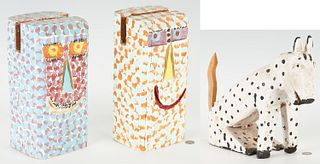Moche Brownware Jaguar Stirrup Vessel, ex Sotheby's PB
Lot 133a
About Seller
Artemis Gallery
686 S Taylor Ave, Ste 106
Louisville, CO 80027
United States
Selling antiquities, ancient and ethnographic art online since 1993, Artemis Gallery specializes in Classical Antiquities (Egyptian, Greek, Roman, Near Eastern), Asian, Pre-Columbian, African / Tribal / Oceanographic art. Our extensive inventory includes pottery, stone, metal, wood, glass and textil...Read more
Estimate:
$1,800 - $2,700
Absentee vs Live bid
Two ways to bid:
- Leave a max absentee bid and the platform will bid on your behalf up to your maximum bid during the live auction.
- Bid live during the auction and your bids will be submitted real-time to the auctioneer.
Bid Increments
| Price | Bid Increment |
|---|---|
| $0 | $25 |
| $300 | $50 |
| $1,000 | $100 |
| $2,000 | $250 |
| $5,000 | $500 |
| $10,000 | $1,000 |
| $20,000 | $2,500 |
| $50,000 | $5,000 |
| $100,000 | $10,000 |
| $200,000 | $20,000 |
About Auction
By Artemis Gallery
Feb 21, 2019
Set Reminder
2019-02-21 10:00:00
2019-02-21 10:00:00
America/New_York
Bidsquare
Bidsquare : Exceptional Antiquities, Asian, Ethnographic
https://www.bidsquare.com/auctions/artemis-gallery/exceptional-antiquities-asian-ethnographic-3858
An important one-day auction featuring museum-worthy examples of Egyptian, Greek, Roman, Etruscan, Near Eastern, Far East / Asian, Pre-Columbian, African / Tribal, Oceanic, Native American, Spanish Colonial, Russian, Fossils, Ancient Jewelry, Fine Art, so much more! Artemis Gallery info@artemisgallery.com
An important one-day auction featuring museum-worthy examples of Egyptian, Greek, Roman, Etruscan, Near Eastern, Far East / Asian, Pre-Columbian, African / Tribal, Oceanic, Native American, Spanish Colonial, Russian, Fossils, Ancient Jewelry, Fine Art, so much more! Artemis Gallery info@artemisgallery.com
- Lot Description
Pre-Columbian, North Coast Peru, Moche, ca. 400 to 700 CE. A beautiful mold-formed pottery vessel with fine burnishing marks across the exterior. The vessel is defined by a planar base, a bulbous body, a stirrup-shaped handle, and a cylindrical spout with a lightly-flared rim. The body emulates the form of a fierce jaguar with a powerful body and extended forepaws, retracted back legs, and tail curled into a tight spiral. Enormous ovoid eyes beneath heavy lids, an upturned nose with delineated nostrils, puffy jowls with bared fangs, and perky ears define the feline visage, and the vessel is enveloped in a chocolate-brown slip. Size: 4.375" W x 7.3" H (11.1 cm x 18.5 cm).
The jaguar symbolized power and might throughout the Pre-Columbian world. Warriors, rulers, hunters, and shamans alike associated themselves with this king of beasts, the largest and most powerful feline in the New World. The principal Moche god wears a headdress adorned with a jaguar head and paws and important mortals donned similar headdresses. A nocturnal animal, the jaguar sleeps in caves and dark places and creeps quietly in the forest, evoking great mystery. Oddly enough, few Moche artists would have actually scene jaguars as they are not indigenous to the coast. Jaguars prefer moist forest conditions. However, scholars believe that some cubs were transported over the mountains for Moche rituals, and it is also possible that some jaguars wandered down the coast.
Provenance: private New York, New York, USA collection; ex-Paul Frank collection, acquired by descent from John Green; acquired and published: Sotheby's, Parke-Bernet (April 11, 1970, lot 77)
All items legal to buy/sell under U.S. Statute covering cultural patrimony Code 2600, CHAPTER 14, and are guaranteed to be as described or your money back.
A Certificate of Authenticity will accompany all winning bids.
We ship worldwide and handle all shipping in-house for your convenience.
#144385Restoration to one ear and part of spout rim, with light resurfacing and overpainting along break lines. Minor abrasions to base, body, and handle, with light encrustations within some recessed areas, and fading to original pigmentation. Light earthen deposits and nice craquelure to slip pigment throughout.Condition
- Shipping Info
-
All shipping is handled in-house for your convenience. Your invoice from Artemis Gallery will include shipping calculation instructions. If in doubt, please inquire BEFORE bidding for estimated shipping costs for individual items.
-
- Buyer's Premium



 EUR
EUR CAD
CAD AUD
AUD GBP
GBP MXN
MXN HKD
HKD CNY
CNY MYR
MYR SEK
SEK SGD
SGD CHF
CHF THB
THB

















